
Foaming and thrashing around a series of beautifully sculpted spits of rock, the north coast sea of Tenerife demands attention. Centuries of powerful waves had crafted the impressive bay of Playa de los Roques in Los Realejos. The beach was sealed as notices warned of possible rock falls, that didn´t deter solo fishermen from taking up precarious perches over this beach and further along the Rambla de Castro walk.

A short bus ride from Puerto de la Cruz station had dropped me in a good position to start the two hour walk looking down from the entrance path behind the blue and white beacon of the Hotel Maritim. I realised I could have walked from El Burgado at the Loro Parque end of Puerto de la Cruz, the baseball stadium of the Marlins was a reliable indicator of my surroundings.


A steep, narrow track upwards through farming terraces led to a modern housing estate and a sharp right turn onto a pathway overlooking the sea. The opportunity to dip down and skirt along just above wave level was being taken by several groups of young walkers. The sheer scale and defiant nature of the isolated rocks told a tale of years of pounding to prise open clefts in the stacks.
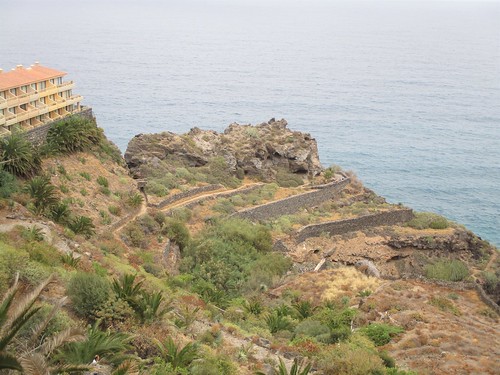
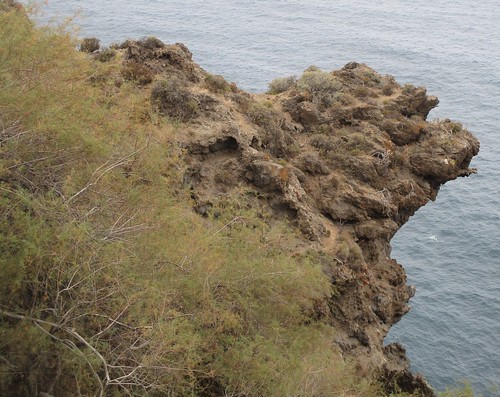
The path looped down through a tight stone arch and round a narrow track that clung to the sturdy cliff. The apray from below added to the feeling of kinship with nature. Back up to the road level, helpful signs pointed onwards to the next interface of sea views. A couple of small streets around an old commercail centre allowed drivers some convenient parking before joining the route in mid flow. The next stage spread out in the distance as the cloudy sky and lush green cascade of plants gave evidence to the increased rain fall in this area. Low edging stones separated the route from the drop below, and wild birdscame and went into concealed caves.



Nearing the mirador of San Pedro, the circular viewing point stood out below just beyond a wooden bridge. History was etched into the Los Realejos coast, one of the most striking examples was the Gordejuela water pumping plant. Built in 1905, it housed the first steam engine to operate in Tenerife. Despite its exposure to the winds and waves of nature, people had been the worst causes of damage. Graffiti daubed over the walls and enlarged window frames gave it a spooky feel but the water pipes trailing up the steep hills showed that the building was made of sturdy stuff. Big waves continued to lick at the walls, not my idea of a remote playground, and the remotest type of urban art gallery.



A path leading up to the busy TF15 road and bus routes was closed off but just a short back track to the commercial centre and an upward stride connected me with Los Realejos bajo and the bus I was seeking. Los Realejos is a deep xlice into the north of Tenerife with the churches and ravines of Los Realejos Alto well worth a look.

Even without the rolling bug eyes and Ringo Starr voice over, my memory was side tracked to thoughts of Thomas The Tank Engine. Half way between Playa de Las Teresitas and Santa Cruz, a 1924 green steam locomotive from Cassel, Germany set my mind chugging near the old ports area of the Tenerife capital.


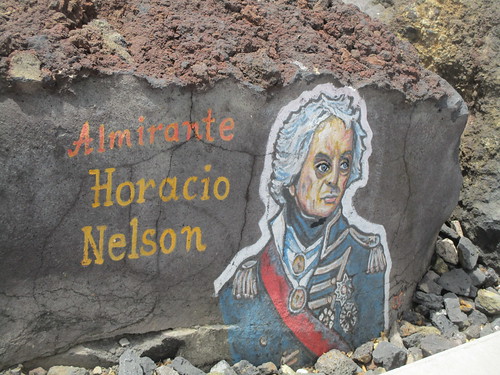
Within five minutes of walking on, a blue 1920 steam crane from Bedford, England (Grafton & Co built) pulled me up. Both machines played a part in the construction and running of the diverse and busy Santa Cruz port that now has big unused gaps waiting to be redeveloped.


Even at the San Andres end of the coast, I had already seen references to maritime history and Horatio Nelson´s failed attack on Tenerife on 25 July 1797. The defeat of the UK icon was in part due to the warning issued by an unknown local lady who spottted the British fleet as she walked to market. Nelson lost his right arm but was treated with respect and honour and his name and image feature prominently around Santa Cruz.
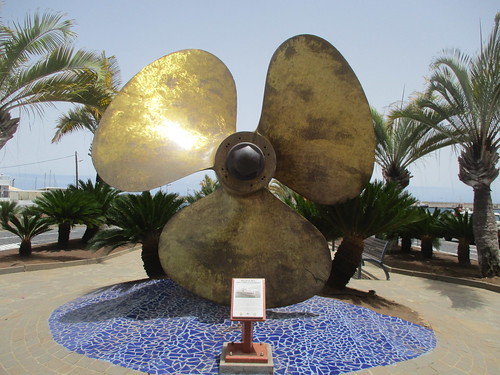
Back to the present and my stroll from San Andres to Santa Cruz, Oil rigs have become regular callers for repairs in recent years, The west Eminence, and West Jupiter from Panama were settled just off shore. Further along, the propeller blade from the Spanish war ship Crucero Canarias, was donated to the city of Santa Cruz in 198o and stands proudly outside the entrance to the old jet foil station.


On this baking hot July day, young bathers were flocking to any available swimming spot in the Valleseco area. A big new sandy beach has been promised to replace the run down stretch. Plans have sparked a debate over lost history and jobs, The CIDEMAT water sports centre is in the firing line for privatisation with 15 workers facing anxious times. Updating a big city is always a tricky call. The work on Plaza de España and the opening up of Santa Cruz to the sea front has been long drawn out but very rewarding, especially the way the past has been honoured.


The walk from San Andres offered up some fine examples of classic past work, such as the sculpted sign on the old Ministry of Work and Immigration, and a strip of classic balconied houses with distinct pink walls. Change is inevitable but hopefully the next batch of modernising will remember those small touches that catch the eye and tweak the sense of pride.

Even cruise liners rubbing shoulders with fishing boats, and a multi coloured meccano bridge, couldn´t compete with Playa de Las Teresitas beach, just north of Tenerife capital, Santa Cruz. Eyes are drawn to the majestic spread of orange sand that gives way to turquoise and blue bands of sea becalmed by a long concrete side arm, and a knobbly ridged dyke peeping out of the water.


Who cares if its a fashion mix that could hint of a teenager on a first date. It works wonderfully and recent upgrades have banished the ramshackle economic shadow of a botched commercial development. Stylish blue and white changing huts and gastro club food bars back stop the beach as lycra wrapped cyclists whizz by below the imposing cliff face. Fishing village San Andres clings to the mountain side at the southern end, and from the far end, the ferry port of Santa Cruz is visible on the horizon.


The gently shelving beach makes it a family favourite and a wonderous discovery to those venturing up from the southern beach resorts, adding about 20 minutes to the motorway journey.The regimented clusters of the tall lean pine trees offer shade, and showers and spacious and abundant along the rear of the beach. Peace of mind is under lock and key with several banks of lockers to save swimming from constant backward scanning of the sand.


The squeezing out of the long established fishing sector to a remote corner is a bone of contention. This important part of local culture, and the crumbled remains of the San Andres defensive tower will probably not be noticed by many visitors, and that´s a missed opportunity. Las Teresitas lures big chunks of the Santa Cruz population across, it is so visually pleasing and offers space for all to stretch out.



For cooling down back in Santa Cruz, there´s always the outdoor Parque Maritimo pool complex, next to the hook nosed auditorium. Open daily from 10 am to 7 pm, it has a selection of pools and chill out areas plus snack and drink outlets. Prices start from five euros per day but they have lots of deals for groups and regular users.

Hot lava carving a path down through the pine forest. Even 111 years later, cold and dormant, the sight was still powerful and invigorating. Chinyero, the Santiago del Teide village where the last Tenerife volcanic eruption halted is forever frozen in time. the placing of the statue of the virgen fom the local church put on the red light and ensured the status of miacle. On previous February walks over the popular route, snow has capped Mount Teide and pink and white blossom dotted much of the landscape. This time a 20 degrees start from Santiago del Teide church plaza met with warmer air as mother nature showed off her summer collection.


Clearly indicated on route boards, the low stone walls guided me out along the compacted and uneven trail. Summer plants bloomed in sheltered corners and the trees chipped in with charred sculptures and coatings of moss. Rising quickly, the path squeezed by a half full reservoir and an old water channel. Big clearings of almond trees were taking a back seat in their plain clothes attire while a welcome chilled breeze marked my cresting of another hill.

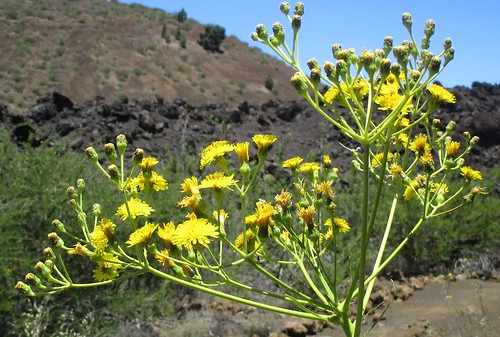
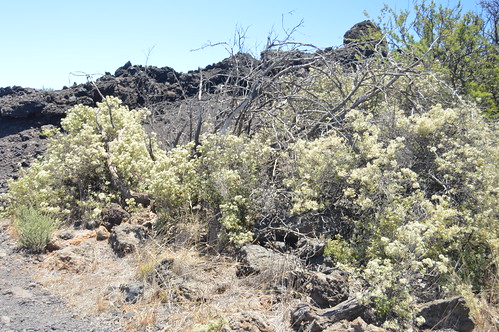
Tell tale twitches and rustles hinted at cautious birds and other wildlife. A large rabbit stood tall in a clump of grass, my heavy footfall had heightened its senses. The wise bunny turned and bounded powerfully away after one whiff of my trainers. Nearly half way on the 9 km stroll brought me to the clearing where the abrupt halt of the 1909 eruption attracts pilgrims and history buffs. Flowers are regularly replenished at the shrine and its a good spot to take a breather.

Moving on the lava rose into a high ridge, help was at hand in the form of guide signals. Basically it was a curl around the ridge before taking some roughly hewn steps onto a clear path picked out between the wave of pine trees and the large mounds of ash and stone. The contrasts were amazing to contemplate, dark brooding boulders, perky green pines, and a clear blue sky as natures components battled for supremecy.



The walk wraps around in almost a complete circle, so Santiago del Teide began to appear in the near distance to one side below. Reassurance of taking the correct path came from yellow and white lines daubed on rocks at key points, a similar two coloured cross was clear advice not to go forward on false trails. The mountain plateau above Arguayo was another good indication of progress to the village finish, and what a wonderful backdrop for the local football stadium. Resting in the spread roots of giant, thick trunked trees was a good chance to cool a little before the final push and a choice.


The undulating nature of the walk left a big descent still to tackle, sign posts indicated two differet routes, past experience had told me they both ended in the same place but presented their own challenges of shifting loose dirt and tufted grass as they meandered between parcels of private land. Arguayo is a small village and I missed the solitary afternoon bus back down to Santiago del Teide (a taxi would be a cheap option) and had to close the circle with a carefull slog down a spiralling main road, adding another hour to a very satisfying day.












































